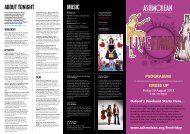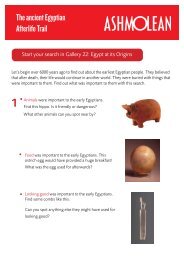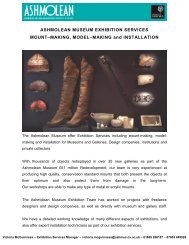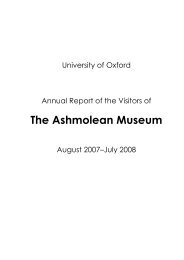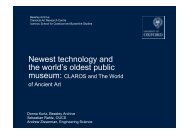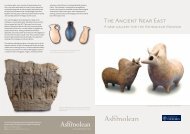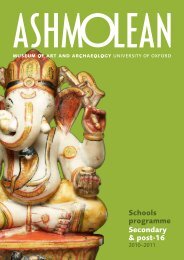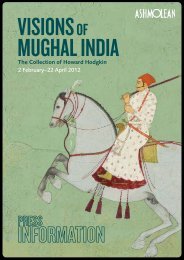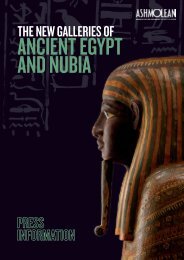The Bronze Age: Canaan - The Ashmolean Museum
The Bronze Age: Canaan - The Ashmolean Museum
The Bronze Age: Canaan - The Ashmolean Museum
Create successful ePaper yourself
Turn your PDF publications into a flip-book with our unique Google optimized e-Paper software.
ANCIENT NEAR EASTERN TERRACOTTAS<br />
(ii)<br />
Early <strong>Bronze</strong> IV to Middle <strong>Bronze</strong> II (c.2300–1650 B.C.)<br />
In the transitional phase between the end of the urban-based cultures of the Early <strong>Bronze</strong> <strong>Age</strong> in <strong>Canaan</strong><br />
and a revival of town-life in Middle <strong>Bronze</strong> IIA, surviving indications of continued human activity are<br />
virtually confined to mortuary contexts, where evidence for imagery of any kind is to all intents and<br />
purposes so far unknown. During this period regular relations between <strong>Canaan</strong> and Egypt, where there<br />
was a two century break in centralised control (“First Intermediate Period”), lapsed (cf. Redford 1992,<br />
57–63).<br />
With the revival of urban life in <strong>Canaan</strong> in the first two centuries of the second millennium B.C. there is<br />
at present little, if any evidence, for a revival of terracotta production before Middle <strong>Bronze</strong> IIB in the<br />
eighteenth to seventeenth centuries B.C. <strong>The</strong> emergence of a <strong>Canaan</strong>ite dominated dynasty (XV) in Egypt<br />
reopened contacts between the two regions. At the same time several significant features in the<br />
archaeological record (mudbrick architecture; new mortuary practices; and ceramic changes) indicate<br />
strong contacts, possible some actual immigration, into <strong>Canaan</strong> from Syria. <strong>The</strong> contrasting cultural and<br />
iconographic influences evident in <strong>Canaan</strong> at this time are exemplified by glyptic, with cylinder seals<br />
illustrating the Syrian ingredient, scarabs the Egyptian. As Keel and Uehlinger (1998, 19) have stressed:<br />
“a person studying Palestine must assume that influences came both from Egypt and the Near East, not<br />
only in regard to matters connected with form and style but also when dealing with semantic issues”.<br />
It would appear that the appearance on <strong>Canaan</strong>ite scarabs at this time of the ‘nude female’, depicted<br />
frontally with her arms down her sides, rather than bent across her abdomen or holding her breasts derives<br />
from the imagery of Syrian seals. Such figurative designs are rare then on Egyptian scarabs. <strong>The</strong> visual<br />
isolation of this figure on scarabs exactly parallels her appearance on baked clay plaques in Mesopotamia<br />
from the late Akkadian Period (c.2150 B.C.) and the self-contained appearance of this motif on Babylonian<br />
cylinder seals of the first centuries of the second millennium B.C.<br />
In the west the so-called Nude Goddess lifting her garments appears first in Syro-Cappadocian and<br />
Anatolian glyptic early in the second millennium B.C. and then more commonly in the “Earlier”<br />
(c.1850–1720 B.C.) rather than in the “Later Syrian Group” of cylinder seals. She does not appear at Tell<br />
Atshana (Alalakh), (cf nos 258 ff) where even the dressed goddess partially revealing herself is rare (cf.<br />
Teissier 1984, 80–1). Barrelet (1955) agreed that the “Winged and Armed Goddess” and the “Nude<br />
Goddess” were all aspects of Ishtar in Syrian glyptic: as goddess of love she is shown revealing herself,<br />
either with her long garment put to one side or by lifting a veil; sometimes both are combined (cf. Teissier<br />
1984, nos 490, 496). Here, as in Babylonia, there remains a degree of ambiguity about the exact status of<br />
this nude female, when neither a horned headdress nor wings indicate divinity in a particular<br />
representation of her.<br />
At present there is no clear evidence that even a sporadic production of zoomorphic terracottas persisted<br />
when anthropomorphic clay images were temporarily eclipsed after the end of the Early <strong>Bronze</strong> <strong>Age</strong>. <strong>The</strong><br />
first type to reappear in clay are doves associated in many ancient Near Eastern cultures with the local<br />
goddess of love. <strong>The</strong> basis for regarding pigeons and doves (the Columbidae family of birds) as models of<br />
lovers is their courtship behaviour, kiss-like billing and cooing, and faithful relationships (cf. Ziffer 1998).<br />
In a Middle <strong>Bronze</strong> II shrine at Nahariyah (Dothan, M. 1956), a coastal site in Northern Israel, clay doves,<br />
generally shown in flight, were the only votives in terracotta, whilst nude female figurines there were in<br />
metal, as at a contemporary shrine at Megiddo (Loud 1948, pl. 245, 18–19; cf. Keel and Uehlinger 1998,<br />
31–37). Male metal figurines are rare at this time and equally absent in clay. At Megiddo (area CC), for<br />
instance, in metal 16 were female, 6 male (Negbi 1976, 131). On contemporary seals in <strong>Canaan</strong> the nude<br />
female is associated with caprids and lions, as well as doves; but at this stage neither she nor her votaries<br />
are apparent in clay images.<br />
-184-




